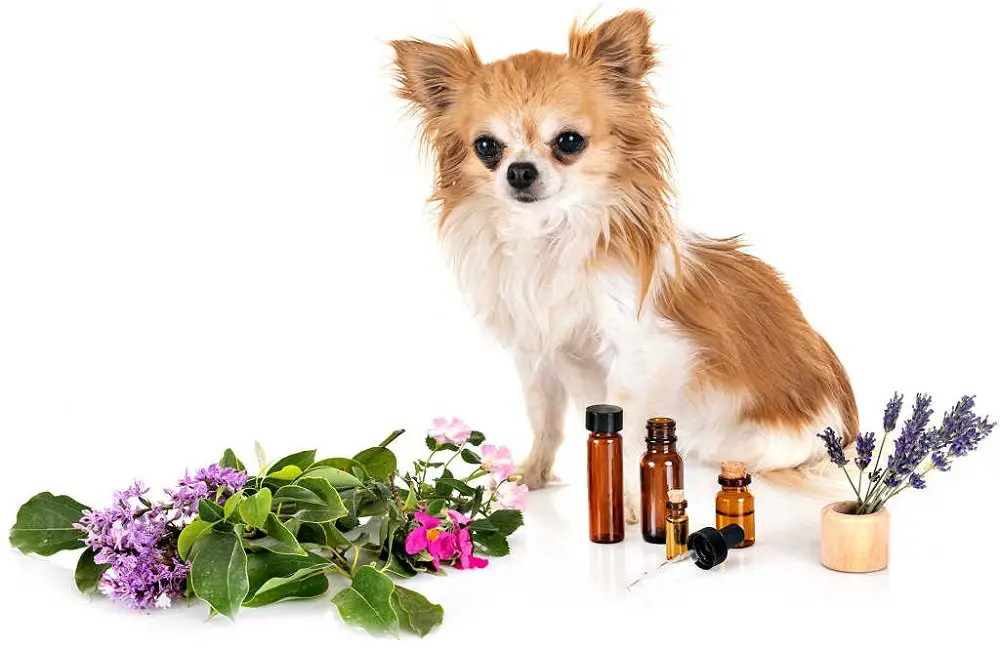Whether you have a stinky dog or a fancy pooch, fragrance oils for dogs have been gaining in popularity in recent years. We all want to take the best care of our canine friends, so asking if fragrance oils are safe is only natural. The answer depends on what is inside your oils. Just as some essential oils aren’t pet-safe, fragrance oils can contain harmful ingredients. No one wants to hurt their pet. Even when it’s accidental, we feel awful. Thus, you should always read the labels and research every individual ingredient. Before anything goes on your dog, you need to know what it is. I’ll share some of my best doggy perfume tips and tricks, along with some good advice about which fragrance oils are safe. However, I recommend choosing a pre-made formula for safety results. Luckily, that’s easier than you think.
Are fragrance oils safe for dogs? Fragrance oils are safe for dogs. Since not all fragrance oils have the same ingredients, you should always check the ingredients list. Compare it to any allergies or problematic substances for dogs before you apply anything to your canine companion. However, in general, fragrance oils lack the problematic essential oils that can cause your pet problems.
What is Inside Fragrance Oil
To find safe fragrance oils for your dog, you need to read the ingredients carefully. Unlike essential oil, there are more ingredients than one. Typically, you’ll see forty to eighty different components on the list. Luckily, that’s still far less than some perfumes.
Because they are synthetic, a fragrance oil will let you choose scents that might otherwise be a severe issue. Lab-created fragrance oils don’t usually have the original plants inside them. Thus you can get more variety and plenty of options for making your favorite fido smell amazing.
Choose a dog-safe and tasty-smelling bottle of The Dog Squad Pupcake Perfume in Cake. With a light scent that lasts up to forty-eight hours, your dog will delight and surprise everyone by smelling as cute as she is. Plus, you get an adorable flower hair clip for your pooch. To get yours from Amazon, click here.
How Fragrance Oil Is Made
To re-create a scent, perfumers must first ‘figure out’ what makes it smell. Quite literally, that means they need the exact chemical composition. Thus a gas chromatographic-mass spectrometric (GC-MS) machine is ideal. While that’s a lot of words uncommon words, it merely means is that the device identifies, on a chemical level, what anything placed inside is. Plus, it can tell you how much of each ‘part’ there is in the mix.
Once they know exactly what makes a smell, using synthetic compounds and occasional organics, they recreate the scent. That’s how you get ‘popcorn, sugar cookies’ or ‘leather,’ scented oils. Once you can see the essential components of smell, it’s a matter of re-adding only those parts together.
Fragrance oils usually contain a combination of natural and synthetic fragrant compounds. Also known as VOCs or volatile organic compounds, some of these come from the original plants, but they are not an essential oil, or at least not anymore. These can be liquid, crystalline, or powder.
To dissolve scent VOCs into an oil form, perfumers use a solvent. One of the most common over the last fifty-plus years is DEP (Di Ethyl Phthalate), which has been declared safe for human use worldwide. However, some use phthalate-free formulas if you prefer.
Additionally, some makers use diluents, such as is DPG (Di Propylene Glycol). The purpose of these ingredients is to reduce the potency of the scent. If you’ve ever smelled a fragrance oil, you’ll understand why less is more in this case. Again, some companies also make un-diluted fragrance oils.
Whatever the formula, the scent, oil, solvent, and potential dilutants are what that label will show. Unfortunately, some fragrance oils use umbrella terms like ‘natural scent’ or ‘parfume’ in place of listing the full formula. Keep an eye out for these, and always ask the company if the particular blend is safe for your pet.
Pet parents seeking a natural scent will love Nature’s Specialties Foo Foo Simply Plum. The unique, fruity bouquet is made for your dog. Thus it’s safe for both adult dogs and puppies. Moreover, the long-lasting scent helps keep your pup stay fresh even between baths. See the Amazon ratings right here.
Which Fragrance Oils to Avoid for Dogs
According to VCAHospitals, “Many liquid potpourri products and essential oils, including oil of cinnamon, citrus, pennyroyal, peppermint, pine, sweet birch, tea tree (melaleuca), wintergreen, and ylang-ylang, are poisonous to dogs. Both ingestion and skin exposure can be toxic.”
Although VCA specifically mentions essential oil and liquid potpourri, it’s safe to assume the same goes for other products. The practical application of that knowledge is that you should never put any of those on your dog. Even a small amount can be dangerous to the largest dogs.
Keep in mind that breeds prone to breathing troubles (brachycephalic), most often the short-faced breeds, are more likely to have difficulty with fragrance oils. Because their lungs are exceptionally delicate, you may want to avoid fragrance oils and use unscented products to remove any offensive odors instead.
Do a Patch Test
Arguably the best way to make sure the oil you’ve chosen is truly safe for your pet is to treat it like any skin or hair product. Do a patch test. First, select an area that is out of the way. For dogs, the back of the neck, between the shoulder blades, is an excellent spot to keep them from licking an oil.
Take a dropper and add a single drop on the skin. After that, you need to leave it alone. Unless there’s a problem and you need to wash it off immediately, leave the fragrance oil spot for a full twenty-four hours. Usually, that’s enough time to ascertain whether there’s a problem.
Symptoms of Accidental Poisoning
Please seek emergency treatment for your pet immediately if they have any of the following symptoms. Do not try to treat this at home. Induced vomiting or even activated charcoal can make things worse.
- Breathing Problems- Lookout for wheezing, excessive panting, and other signs your pooch is having issues getting air.
- Drooling- While some drool is healthy, we mean excessive drooling in this case.
- Fragrance- It might seem like a given, but scents on your dog’s breath, in their vomit, or on their body can indicate a problem. We all know our pets can get into things they shouldn’t, and it’s possible they got more than you intended.
- Lethargy & Weakness- If your pet can’t get up, won’t play, or oversleeps, then you have a problem.
- Muscle Tremors & Seizures- Shaking is not a normal reaction for most pets. If your chihuahua needs to use the bathroom, that’s alright, but unusual or unexpected shivering and shaking is a terrible sign.
- Pawing- If your dog seems to be trying to claw at their head, face, or inside their mouth, this is a form of communication. Your favorite fido is telling you something is wrong.
- Redness- If any part of your dog’s skin or mouth shows new and sudden signs of redness or burns, then they’ve had an adverse reaction to something in the fragrance oil.
- Trouble Walking- When your pet can’t stand or walk normally or even looks a little drunk as they move around, this is a sign of poisoning.
- Vomiting- Throwing up is one way an animal’s body tries to rid itself of toxins.
Mixing Fragrance Oil Perfume for Dogs
For those pet lovers who prefer to DIY, making the right scent for your precious pet is incredibly rewarding. Once you’ve chosen your fragrance oil, I recommend diluting it into a carrier oil. About three drops of fragrance for every twelve to twenty drops of carrier oil is the right proportion.
A few of the best carriers for dogs are aloe vera, avocado, coconut, jojoba, grapeseed, and sunflower. Always make sure you choose both a safe carrier oil and a fragrance. When in doubt, it’s better to opt for a pre-made scent.
Gotdog Timmy Holedigger Dog Cologne is a fun, less feminine scent for your favorite furry friend. Simply spray between the shoulder blades for a fresh and fragrant dog. You’ll appreciate the lack of floral or traditionally ‘girly’ perfumes. Find out more on Amazon by clicking here.
By choosing a pet-safe carrier oil like coconut, you can stretch your fragrance oil much further. You can use this in a warm bathtub, or spray it on like you would for a human. Either way, you will get a superbly scented dog.
Sure, some people love the wet puppy smell. Yet, for the rest of us, it is easy to understand why pet perfume is desirable. From expressing their anal sacs to rolling in dead things, dogs do all sorts of unpleasantly smelly stuff.
Final Thoughts
Fragrance oils can be perfectly safe for your dog. However, you need to check all the components before you apply anything. Fortunately, in a good, high-quality fragrance oil, the ingredients list is easy to find. If not, you can send an inquiry to the company.
When you can’t learn what’s inside a product, you should never put it on your pet. Sadly, many things that are alright for humans are toxic to dogs. Keeping your pooch safe should always be your priority as a pet parent.
Make sure you choose fragrance oils that come from trusted and open sources. You can make your pet smell amazing while still protecting them.

